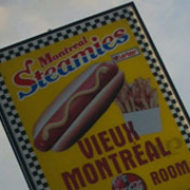A week ago today, I visited the World Soundscape Project at Simon Fraser to talk with Barry Truax and his students. For those who read this blog and know me in some other way than as a sound scholar, The WSP and the group of people involved with it — R. Murray Schafer, Barry Truax, Hildegard Westerkamp and many others — are probably still the best-known intellectual contribution of Canadians to thought about sound. (The other being the so-called Toronto School with McLuhan, Ong, et al.) There’s probably an interesting essay in the question of why Canadians developed so much influential thought about sound in the 60s, 70s, and 80s. But I have always understood my own work as a political and theoretical departure from those traditions. So it was interesting to finally meet some of the main figures in the tradition and have real exchanges with them, along with students working in the field today.
This experience, along with hearing Barry’s work live and meeting Hildegard Westerkamp at the Listen Again conference was something of a revelation for me. I have always preferred their work to R. Murray Schafer’s, as both have a much stronger sense of the mediality of sound and have much more sophisticated takes on recording and signal processing as aesthetic and political practices. Truax’s Acoustic Communication is a singular book, especially when you read it in the intellectual context of its time. But the truth is that I probably have given less time to acoustic ecology as a tradition than I should, mostly because I find Schafer’s politics so utterly reactionary.
The visit was a real delight. I had lots of time to talk with Barry and to learn from him, both about the history of the project (and Schafer’s Tuning of the World) and about his own work, which includes the first real-time actualization of granular synthesis. Granular synthesis (and granulation) are techniques I find both fascinating intellectually and sonically appealing. (In fact, they’ve helped me understand digital audio in a fundamentally new way, but that’s a story for another time). It was also great to meet his students and to see the space. I was somehow expecting a massive archive of tapes, but the project’s archive of recordings is actually remarkably compact.
Its housing also contains a nice synoptic media history.
In this picture from 1982, you can see Hildegard Westerkamp standing in front of the tapes, which all exist in analog form, with a few digital copies on betamax (!) tape:
In my picture from last week, below, you can see more of the history. The archive started out on analog tape — shown at the top and bottom of the shelf. In the late 70s and 80s (I hope I have my dates right) — they archived those analog tapes to digital audio tape on betamax (2nd, 3rd and 4th shelves from the top). The next move was to DAT (Digital Audio Tape) in the 1990s (5th shelf down–the small one). I love the piles of CD-Rs and the spindle of blank CDs, which are not archival formats but rather their mode of distribution for people interested in obtaining copies, and which push the history into the 2000s.
They are currently archiving the analog recordings again as digital files that will live on a hard drive with a database and links to images of the places recorded. I’m hoping to acquire a copy of the archive for McGill. But of course that can’t be pictured in the same way. The archive will disappear inside the hardware. A single hard drive could contain much more than that whole shelf. The digital life of the WSP is a story of formats, more than media. Which is also a point I belabor in my mp3 book–that formats, as well as “media” in the traditional sense, need to be considered as subjects of communication history.
Anyway, last Monday we spent a couple hours talking about our different interests and approaches to sound. And it ended with a little show and tell, as Barry explained why he was able to do tempo-synced rhythms in his newer work but not in his original 1986 Riverrun composition (which is the piece where realtime granular synthesis was first achieved). In exchange, I showed in Audio Ease’s Riverrun, a piece of software named for his composition and the tool through which I first explored granulation of audio. I’d been having problems with it in terms of stability and interface, but I was able to get it to behave long enough to turn a Prince song into a long, evolving soundscape (and it appears a new update just appeared, which I just downloaded).
I don’t think I will ever call myself an acoustic ecologist (and was interested to learn Barry doesn’t call himself one), and we didn’t even get into epistemology and method (or rather, they asked those questions, and I didn’t have the presence of mind to turn it around). Most of Schafer’s core concepts–soundscape, hi-fi/lo-fi, schizophonia, etc–still trouble me. But I’m really pleased to have met everyone I did, and more importantly, to get a better sense of the real intellectual diversity in the living tradition of discourse about soundscapes. I’m sure there will be other chances to talk . . . .
